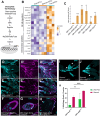Multi-modal comparison of molecular programs driving nurse cell death and clearance in Drosophila melanogaster oogenesis
- PMID: 39752622
- PMCID: PMC11734916
- DOI: 10.1371/journal.pgen.1011220
Multi-modal comparison of molecular programs driving nurse cell death and clearance in Drosophila melanogaster oogenesis
Abstract
The death and clearance of nurse cells is a consequential milestone in Drosophila melanogaster oogenesis. In preparation for oviposition, the germline-derived nurse cells bequeath to the developing oocyte all their cytoplasmic contents and undergo programmed cell death. The death of the nurse cells is controlled non-autonomously and is precipitated by epithelial follicle cells of somatic origin acquiring a squamous morphology and acidifying the nurse cells externally. Alternatively, stressors such as starvation can induce the death of nurse cells earlier in mid-oogenesis, manifesting apoptosis signatures, followed by their engulfment by epithelial follicle cells. To identify and contrast the molecular pathways underlying these morphologically and genetically distinct cell death paradigms, both mediated by follicle cells, we compared their genome-wide transcriptional, translational, and secretion profiles before and after differentiating to acquire a phagocytic capability, as well as during well-fed and nutrient-deprived conditions. By coupling the GAL4-UAS system to Translating Ribosome Affinity Purification (TRAP-seq) and proximity labeling (HRP-KDEL) followed by Liquid Chromatography tandem mass-spectrometry, we performed high-throughput screens to identify pathways selectively activated or repressed by follicle cells to employ nurse cell-clearance routines. We also integrated two publicly available single-cell RNAseq atlases of the Drosophila ovary to define the transcriptomic profiles of follicle cells. In this report, we describe the genes and major pathways identified in the screens and the striking consequences to Drosophila melanogaster oogenesis caused by RNAi perturbation of prioritized candidates. To our knowledge, our study is the first of its kind to comprehensively characterize two distinct apoptotic and non-apoptotic cell death paradigms in the same multi-cellular system. Beyond molecular differences in cell death, our investigation may also provide insights into how key systemic trade-offs are made between survival and reproduction when faced with physiological stress.
Copyright: © 2025 Bandyadka et al. This is an open access article distributed under the terms of the Creative Commons Attribution License, which permits unrestricted use, distribution, and reproduction in any medium, provided the original author and source are credited.
Conflict of interest statement
The authors have declared that no competing interests exist.
Figures







References
-
- King RC. Ovarian Development in Drosophila Melanogaster. Academic Press: New York, NY, USA, ISBN 9780124081505. 1970. [cited 20 Dec 2023]. Available: https://cir.nii.ac.jp/crid/1370004237568899203.
-
- Spradling A. Developmental genetics of oogenesis. The development of Drosophila melanogaster. 1993. Available: https://ci.nii.ac.jp/naid/10016991326/
-
- Giorgi F, Deri P. Cell death in ovarian chambers of Drosophila melanogaster. J Embryol Exp Morphol. 1976;35: 521–533. - PubMed
-
- Drummond-Barbosa D, Spradling AC. Stem cells and their progeny respond to nutritional changes during Drosophila oogenesis. Dev Biol. 2001;231: 265–278. - PubMed
MeSH terms
Substances
Grants and funding
LinkOut - more resources
Full Text Sources
Molecular Biology Databases

